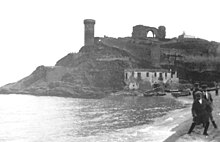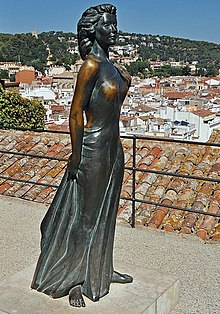Vila Vella (Tossa de Mar)
The Vila Vella is the historical center of the Catalan town of Tossa de Mar . Surrounded by walls and seven towers, it is one of the main attractions of the Costa Brava and is a listed building .
location
There is a land bridge between the mouth of the Tossa River and the small Es Codolar bay , which connects an offshore peninsula with the mainland. This peninsula consists of a mountain, the Mont Guardí, with steep cliffs sloping towards the coast. These form a natural protection. On the land side of this peninsula, the city wall continues the towering cliffs and thus delimits the old town.
history
Historically, people settled in the small fishing and farming village on the plain that today forms the new town of Tossa. A Roman settlement with an Iberian forerunner was discovered in 1914 on what is now the western edge of the town. In 966 Count Miró of Barcelona ceded the area to the Benedictine Abbey of Santa Maria de Ripoll ; this retained the formal sovereignty over the surrounding area until the end of feudalism in Spain in 1835. In 1187 the abbot of Ripoll granted Tossa de Mar town rights.
In connection with the granting of city rights, the construction of the city wall and the fortification towers began in the 12th century. Construction was completed in the 14th century and has been preserved in this form. After the end of the Reconquista in 1492, the facilities lost their function against internal Spanish enemies and now served to protect against the Barbaresque corsairs . This military function was supplemented by the Agulla de Pola watchtower located about four kilometers to the north and the nearby Torre des Moros watchtower , both of which are in visual contact with the old town.
Over the centuries this danger diminished and the city also grew outside the city walls. A milestone in this development was the laying of the foundation stone for the church of Sant Vicenç in 1755 in today's new town. The old church in the old town fell into disrepair and is now in ruins.
Since the city walls no longer had any military significance since the 19th century, they were no longer maintained. In the Spanish Civil War 1936-1939 Tossa theater of war. While the new church and the new town were damaged, the city wall remained intact.
In 1951 the impressive panorama of the old town was used as a backdrop for the film Pandora and the Flying Dutchman with Ava Gardner and James Mason . The film made Tossa de Mar known worldwide and led to a boom in tourism. As a result, the damage in the wall was repaired and paths and lighting were installed.
The city wall
The main entrance to the old town is on Carrer des Portal , to the right of the tallest tower of the city fortifications, the Torre de les Hores . To the left of the gate is the Creu de Terme crossroads, which is also a listed building. The Torre de les Hores is one of the three towers of the city wall that still bear a crenellated wreath today. If you follow the massive, high city wall outside towards the south on Carrer des Portal, a street dominated by restaurants, you will come to a second city tower after a few meters at the junction with Carrer des Codolar. This is only completely preserved up to the height of the battlements of the city wall; of the upper part only the half-tower facing outwards is preserved. If you follow the course of the wall, after a short climb you will reach the Torre des Codolar , which dominates the bay of the same name, Es Codolar. Here the city wall turns, secures the possible ascent from Es Codolar and ends in the steep cliffs on the side of the bay. The square in front of the Torre des Codolar is designed as a viewing platform. In the middle is the sculpture A la dona del pescador![]()
![]()
![]()
While the city wall was closed here in the past, there is now a man-high entrance to the old town. This leads to the Placa del Pintor Joan Roig Soler. This square, formed by the convergence of Carrer d'Ignasi Melé, Carrer de l 'Abat Oliba and Carrer Vincenc Olivier, is dominated by the former governor's house, now a municipal museum. Here you can climb the ramparts of the city wall via a staircase and follow the course of the wall above around the city. The entrances to the towers on the level of the battlements are closed with iron bars. The course of the city wall from here via the Torre des Codolar to the Torre de les Hores is already described above. At the Torre de les Hores the course of the wall bends and now secures access to the old town from Tossa's main beach, Platja Gran. Here the wall is supplemented by three towers, none of which have a crenellated crown. After the last of these towers, the wall rises steeply and leads to the Torre d'en Joanàs , which secured the western corner of the city. Immediately afterwards you cross the last gate of the city. The well-developed Passeig de la Vila Vella leads from the main beach over many turns through this gate into the old town. The wall ends at the level of the old church. There the steep slopes of the mountain once served to defend the city.
![]()
The seven towers and three gates of the city wall
The old town
The way to El Far
The statue of Ava Gardeners
Most tourists climb the winding Passeig de la Vila Vella along the city wall and enter the old town through the western gate. If you follow Passeig de la Vila Vella to the next bend, you will reach the statue of Ava Gardener on a hill that has been developed as a lookout point. The bronze monument by the Catalan sculptor Ció Abellí commemorates the American actress who made the place famous. The life-size sculpture shows Gardener in the role of Pandora, as she looks out over the sea and the ship of the Flying Dutchman.
![]()
The ruins of the old church
If you follow the road further, after two switchbacks you come to the ruins of the old church . St. Vincent is also a listed monument.
![]()
The first documentary mention of a St. Vinzenz church dates back to 966. After the town charter was obtained in 1186, the construction of a new parish church began. The relics and the baptismal font of St. Vincent were transferred to the new church, and the cemetery moved there. The narrowness of the square on the mountain allowed only a small church to be built. In January 1625 the church received two bells. These were cast in Olot by Miquel Calsa and cost 55 Barcelona pounds. In the following century, the structure of the church suffered from its exposed location on the hill. The focus of the place also shifted more and more from the old town. In 1778 the new church was built and the old church was left to decay.
The Gothic church building was originally single-nave with two chapels on the side to preserve the cross shape. A bell tower on a square base and a sacristy were added later. Today only the apse remains. Fragments of the surviving architectural elements indicate the sculptor Pere Oller, who worked in Girona and Ripoll. Today the church ruins are used as a picturesque setting for open-air performances.
The Torre del Castel
The Torre del Castel is located above the church ruins . It is the remainder of a round tower and was originally part of the fortifications of the old castle.
![]()
El Far
At the top of the mountain, 60 meters above sea level, is the El Far lighthouse . It is eleven meters high and has a square floor plan. The lighthouse information center is on the ground floor. At the top of the tower is a small square tower measuring 4 × 4 meters. On top of this is a cylindrical structure with the actual beacon .
![]()
The castle of Tossa was originally located on the site of today's lighthouse. After it lost its military importance, a windmill was built on the top of the mountain instead. In 1904 it was decided to build another lighthouse between the existing lighthouses in Palamós in the north and Calella in the south. Due to its location in the middle between these places, Tossa was chosen as the location and the building permit was granted on December 5, 1912. The mill was demolished and a supply road was built. The lighthouse was built by 1917. The budget for the construction of 77,100.53 pesetas was exceeded by 16,000 pesetas. The executive architect was José March Docet. Construction had been delayed because the London company Chance Brothers delivered the beacon with a delay due to the war. The lighthouse started operating on August 29, 1917. It was initially run on light petrol. In 1922 the company was converted to Ethin . This was generated from calcium carbide by a gas generator. The lighthouse has been operated electrically since April 1929.
Individual buildings
Further single houses in the old town are under monument protection:
The governor's house
The governor's house was now used as the Museu Municipal de Tossa de Mar as a municipal museum. It is a three-storey building that is attached to the inside of the city wall directly on the Torre des Codolar . The 14th century building was used by the governors of the Ripoll Monastery, who were the landlords of Tossa until 1835 . In 1974 the city acquired the house, which had been privately owned until then, and set up the museum in it. It shows works of art by artists related to Tossa and archaeological finds from Tossa.
![]()
Ca na Marieta Xerach
The two-storey house at Pl. D'Armes, 2 opposite the main gate of the old town, was previously divided into two houses. One of them was the old rectory.
![]()
tourism
The old town of Tossa is named in the travel guides as one of the leading attractions on the Costa Brave. The number of visitors is correspondingly high in the summer months. There are organized bus tours from the main tourist areas in Catalonia to Tossa, also consist ship connections from Blanes and Lloret de Mar . Tourists also have the option of taking a tourist train for the ascent.
Monument protection
The old town and the city walls are protected under the name Recinte emmurallat i Castell de Tossa (Tossa de Mar) (BCIN 227-MH) as the Bé Cultural d'Interès Nacional , which is the highest level of monument protection in Catalonia.
Web links
- CCS entry on the website of the Consell Commarcal de la Selva
- Vila Vella on the side of the town of Tossa de Mar


















